May 2, 2008
Air Date: May 2, 2008
FULL SHOW
SEGMENTS
Congress’ Chemical Concerns
/ Jeff YoungView the page for this story
Powerful Congressional committees want to know what’s gone wrong with toxic chemical regulation and the science that’s needed to safeguard public health. Living on Earth's Jeff Young tells us the wave of investigations are tied to public outrage over potentially toxic baby bottles. (04:00)
Manufacturing Uncertainty
View the page for this story
By raising questions about the scientific research on how some chemicals affect human health, the corporations that manufacture them are able to stall the governmental regulatory process, says Dr. David Michaels of the George Washington School of Public Health. Dr. Michaels talks with host Bruce Gellerman about his new book, “Doubt is Their Product: How Industry’s Assault on Science Threatens Your Health.” (05:30)
Emerging Science Note/Portable Toxic Testing
/ Margaret RossanoView the page for this story
Heavy metals can’t hide from a new pocket-tester, designed to measure levels of dangerous metals with just a prick of a finger or a drop of saliva. Living on Earth’s Margaret Rossano reports. (01:30)
Protecting the Polar Bear
View the page for this story
Protecting the polar bear under the Endangered Species Act could force the government to take action on global warming and development in the Arctic. Host Bruce Gellerman talks with Bill Snape from the Center for Biological Diversity, one of the plaintiffs who sued the federal government to make a decision about the polar bear. (03:00)
Sealing the Sarcaphagus
View the page for this story
More than twenty years after the Chernobyl explosion, Host Bruce Gellerman looks at plans to entomb the crumbling sarcophagus over the nuclear reactor in the Ukraine. (07:00)
Re-education at Camp Chaparral
/ Ingrid LobetView the page for this story
When you go into a national forest, you expect to see trees, but in southern California the forests are covered with shrubby plants known as chaparral. Living on Earth’s Ingrid Lobet visits San Bernardino National Forest and talks with scientists who are trying to protect the dry vegetation. (09:30)
Beautiful Minds
View the page for this story
Dolphins and apes have a lot in common. After humans, they have the biggest brains. And both mammals use tools, are social, and highly communicative. Biologist Maddalena Bearzi and primatologist Craig Stanford explore these similarities in their book “Beautiful Minds: the Parallel Lives of Great Apes and Dolphins” and speak with host Bruce Gellerman. (07:00)
A Rolling Stone Gathers Trees
View the page for this story
When keyboardist Chuck Leavell isn't on tour with the Rolling Stones, he's hanging out at his Georgia tree farm or lobbying the government to support sustainable forestry policy. Host Bruce Gellerman and Chuck listen to songs from his latest solo CD and talk about his fondness for forests. (09:00)
Show Credits and Funders
Show Transcript
HOST: Bruce Gellerman
REPORTERS: Jeff Young, Bruce Gellerman, Ingrid Lobet
GUESTS: Maddalena Bearzi, Chuck Leavell, David Michaels, Bill Snape, Craig Stanford
[THEME]
GELLERMAN: From Public Radio International – this is Living on Earth.
[THEME]
GELLERMAN: I’m Bruce Gellerman. A former federal official blows the whistle on industry’s control of government science.
MICHAELS: They're building in structures within the regulatory process to magnify that uncertainty, to say - well, if there's uncertainty, if there's disagreement we'll do more studies, we’ll do more reviews. It's paralysis by analysis.
GELLERMAN: Also, polar bears come in from the cold, due to global warming.
SNAPE: The polar bear clearly is the canary in the coal mine. You’re seeing an arctic ecosystem collapsing. You’re seeing the walrus, the narwhal, birds and seals all declining because of arctic ice-melt.
GELLERMAN: Now a federal judge puts the heat on the Bush administration, ordering it to decide once and for all if polar bears need protecting. And no moss grows on this Rolling Stone. The rock group’s keyboardist is a tireless tree hugger. These stories and more this week on Living on Earth. Stick around!
ANNOUNCER: Support for Living on Earth comes from the National Science Foundation and Stonyfield Farm.
Congress’ Chemical Concerns

Baby bottles containing BPA have been pulled from some store shelves; Congress wants to know how they got there. (Photo: joker4u2nv09)
GELLERMAN: From the Jennifer and Ted Stanley Studios in Somerville, Massachusetts – this is Living on Earth. I’m Bruce Gellerman, in for Steve Curwood. From supermarket shelves to the halls of Congress, some chemicals used in everyday products are coming under intense scrutiny. Stores are pulling items, including baby bottles, that contain a potentially hazardous chemical known as BPA, or bisphenol A. And Congress has launched multiple investigations into the scientific process and regulatory agencies that are supposed to ensure the safety of the stuff we buy.
In a moment we’ll hear from a former federal official who says the system is corrupt and broken. But first, to Capitol Hill, with Living on Earth’s Washington correspondent Jeff Young.
YOUNG: Powerful congressional committees want to know what’s gone wrong with toxic chemical regulation and the science that’s needed to safeguard public health. The Senate’s environment committee heard a stinging report from the Government Accountability Office about changes the Bush administration made to an important chemical assessment program. The GAO's John Stephenson told the committee that political appointees now weigh in on a process that should be left to scientists.
STEPHENSON: They’re getting involved in the science portion in the early assessment of chemicals. They should not be muddling in the front part, in the science.
YOUNG: Stephenson says that jeopardizes science that’s vital to developing regulation, targets for cleanups or other public health protections. The GAO found bureaucratic hurdles swamped the Environmental Protection Agency’s work, delaying assessments of some likely carcinogens by years. Stephenson says the Defense Department delayed for a decade an assessment of the engine-degreasing agent TCE, which contaminates drinking water near some military bases. And his report shows that the Defense Department and other agencies can affect EPA’s chemical assessments without the public even knowing about it. California Democratic Senator Barbara Boxer chairs the environment committee.
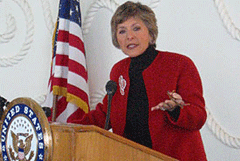
Congresswoman Barbara Boxer. (Courtesy of the U.S. House of Representatives)
BOXER: So Instead of having the scientists at EPA decide what’s good for our health, we now have contractors, essentially, at the table. And what makes it worse is the entire process is kept secret.
YOUNG: EPA’s James Gulliford, who leads the agency’s toxic substances office, defended the process.
GULLIFORD: Ultimately it’s still, at the end of the day, it’s EPA’s decision. So I believe it’s a very – it is a transparent process. It’s a process that ultimately results in a science-based result.
YOUNG: The powerful House Committee on Energy and Commerce is also investigating the chemical industry’s influence. Democrat John Dingell of Michigan wants the industry’s main lobbying group, the American Chemistry Council, to provide details on nine scientists with ties to the industry who served on EPA’s expert review panels. Chemistry Council vice president Sharon Kneiss says the industry will cooperate with the investigation
KNEISS: We continue to provide government agencies with data regardless of the findings because we are proud stewards of our products.
YOUNG: So why all these investigations now? Well it’s largely due to revelations about the chemical bisphenol A. BPA, as it’s known, is in some plastic containers, including baby bottles, and it shows up in blood samples from infants. Animal studies show BPA affects reproductive health and development of the brain. New Jersey Democratic Senator Robert Menendez co-sponsored a bill to ban BPA, something he says regulators should have done already.
MENENDEZ: The whole purpose of our regulatory bodies is to ensure that the public’s health, safety and security is preserved, and you don’t do that as a clean up brigade; you do that as a preventer of bad things from happening, and so yeah, it does bother me a great deal.

(Baby bottles containing BPA have been pulled from some store shelves. Photo: joker4u2nv09)
YOUNG: The chemical industry and Food and Drug Administration say products containing BPA are safe. But as parents toss out suspect sippy-cups and retailers remove bottles from shelves, it’s clear many people do not agree. Richard Wiles at the Environmental Working Group says that’s focused the public on chemical consequences and forced Congress to act.
WILES: Babies will be exposed to toxic chemicals because industry has corrupted the science, and public health protections aren’t forthcoming. What began as an investigation of a contaminant in baby bottles has expanded into a government – a congressional -wide probe into corrupt science.
YOUNG: Out of the mouths of babes, as the good book says. For Living on Earth I’m Jeff Young in Washington.
Related links:
- The Senate environment committee’s hearing on chemical assessments includes a link to the GAO report
- The House energy and commerce committee’s investigation of chemical industry
- The Environmental Working Group’s report on BPA in children’s products
- The American Chemistry Council’s response to concerns about BPA
Manufacturing Uncertainty
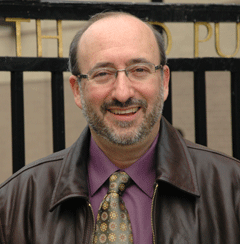
Author David Michaels (Photo: Dawn Garrott, The George Washington University Medical Center)
GELLERMAN: Well the spotlight, if not the interrogation lamp, is on the government agencies that are supposed to safeguard public health from toxic chemicals. David Michaels served as a senior official in one of those agencies. He now directs the Project on Scientific Knowledge at George Washington University’s School of Public Health. In his new book, “Doubt is their Product: How Industry’s Assault on Science Threatens your Health,” Professor Michaels charges companies are actively manufacturing scientific uncertainty to confuse lawmakers and the public.
MICHAELS: This has become a big industry. What polluters have seen is that the strategy that the tobacco industry came up with, which essentially is question the science, find the controversy, and magnify that controversy, is very successful in slowing down public health protections. And so the scientists who used to work for the tobacco industry are now working for most major chemical companies – certainly the big polluters – creating studies that show the opposite of studies done by government regulators and government scientists. They don’t have to show a chemical exposure is safe – all they have to do is show that the other studies are in question somehow. And by raising that level of uncertainty, they throw essentially a monkey-wrench into the system.
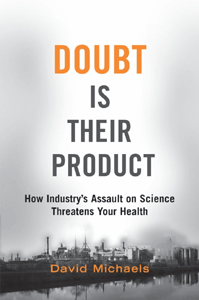
What’s happening above that, though, is the Bush administration is institutionalizing that uncertainty. They’re building in structures in the regulatory process, in the information flows within the government, to magnify that uncertainty and say, well, if there’s uncertainty, if there’s disagreement, we’ll stop, we’ll do more studies, we’ll do more reviews, we’ll make sure everybody involved agrees on the science, which of course they won’t, and everything is just stopped; it’s paralysis by analysis.
GELLERMAN: Well, you worked in the Clinton administration. You were the assistant secretary in the Department of Energy for environment, safety, and health. Did you see this going on during the Clinton administration?
MICHAELS: I did. In fact, that’s why I got involved in this question, and that’s why I wrote my book, “Doubt Is Their Product.” I was the regulator at the nuclear weapons complex, in charge of protecting the health of workers, the communities, the environment around the nation’s most dangerous facilities. Industries that produced products we used – dangerous products – would send in studies that I knew were just nonsense, that pretended to say these things were safe, when we knew in fact they were dangerous. My whole staff would look at these and say, well we know it’s just company X doing this work – of course they’re lying. Unfortunately now in the Bush administration, those studies are elevated to equal status of the better studies that are done by independent scientists. The two sets of studies are virtually used to cancel each other out and stop the Environmental Protection Agency from protecting the health of Americans.
GELLERMAN: Let’s talk about a chemical that’s in the news lately. It’s called bisphenol A, and there was a study that showed that it had a neurotoxic effect on fetal development. Congress is investigating the way industry behaves with these studies, because they say that they influence some of the studies around this chemical.
MICHAELS: That’s right. Congress is looking at what they’re calling ‘science for sale,’ and it’s a reasonable term. What the bisphenol A industry has done is hired a product defense consulting group, a group that’s worked for decades for the tobacco industry, essentially to help shape the national debate over this chemical, and to promote the small number of studies that were done by industry that show no effect, and trying to convince the government and the public to ignore the well over 100 studies that show that low-dose exposure to bisphenol A has a deleterious impact. But what it looks like at the end is equal and opposite studies, with an attempt essentially to paralyze any sort of forward movement on that.
GELLERMAN: You know Senator Barbara Boxer held hearings recently about a new government accountability office report that says that the EPA isn’t doing its job in regulating and testing chemicals. She said that just four out of 70 backlogged chemicals were evaluated last year?

Author David Michaels. (Photo: Dawn Garrott, The George Washington University Medical Center)
MICHAELS: That’s right. There are EPA scientists who are doing their best to turn out credible assessments of these chemicals. And then they run up against the political appointees at the top of the EPA and the White House, who are being told by, essentially, corporations what to do, and they kill all of these assessments, these evaluations. The EPA is essentially paralyzed.
GELLERMAN: You know, Professor Michaels, when a person hears this, they’re gonna say, my government has been infiltrated and is broken, fundamentally broken. In your book you actually quote comedian Lily Tomlin, and she says, ‘no matter how cynical you are, it’s never enough to keep up.’ So my question to you is what’s a person to do?
MICHAELS: Bruce, that’s a very good question. It’s certainly enough to make you very cynical. We need a lot more transparency, and I’m hoping that the next administration, the next president, whoever that is, guarantees that all of these decisions around how we regulate chemicals, how we measure the effects on people’s health, are done in a way that’s transparent. Everybody should see how these decisions are made. The Bush administration is notorious for its devotion to secrecy. In fact there’s every reason to think right now the shredders are all going right now, so we’ll never be able to figure out exactly who made these decisions, how, and why. But the next administration’s gonna have to clean this up.
GELLERMAN: David Michaels directs the Project on Scientific Knowledge and Public Policy at the School of Public Health and Health Services at George Washington University. His latest book is called “Doubt Is Their Product: How Industry’s Assault on Science Threatens Your Health.” Thank you very much, Professor Michaels.
MICHAELS: Thank you so much for having me on.
Related link:
To read secret government documents used in David Michaels' book, click here
[MUSIC: DJ Logic/Jason Miles “A Jam For Joe” from Global Noize (Shanachie – 2008)]
GELLERMAN: Just ahead – polar bears in need find a friend in deed. He’s a federal judge. But first this note on emerging science from Margaret Rossano.
Emerging Science Note/Portable Toxic Testing
[MUSIC: Tom Lehrer “The Elements”]
ROSSANO: Tom Lehrer may have sung about them in a satirical song, but toxic heavy metals like lead, cadmium and mercury are no laughing matter.
[THEME]
Studies have found that children with elevated levels of lead in their blood may experience reduced IQ and other learning disabilities. Cadmium is known to be carcinogenic, while mercury can damage the central nervous system. Unfortunately, testing people for exposure to toxic materials is labor intensive, time consuming and can be expensive. Now, Pacific Northwest National Laboratory has invented a portable system that may remedy these obstacles.
The usual way to measure levels of toxic materials in individuals is to take fluid samples and send them for analysis at a laboratory. Pacific Northwest Lab’s new device can detect levels of toxic metals from blood, saliva and urine, and – unlike a mass spectrometer in a laboratory – provides results within minutes. Fluid samples from individuals can be as small as a drop of blood from a finger prick.
The new portable machine is also as accurate as the larger machines, and will cost about 10 times less. The lab is currently seeking industrial partners to mass-produce and sell the devices. Once on the market, the new detection system will have a wide range of applications, from clinical diagnosis at hospitals, to industrial monitoring for worker exposure to toxic metals at manufacturing plants, to environmental monitoring for toxic metals in local water supplies. Faster, cheaper analysis may help in developing new strategies to reduce exposure and risks.
That’s this week’s note on emerging science. I’m Margaret Rossano.
GELLERMAN: Coming up – a cover up at Chernobyl to prevent another nuclear disaster. Keep listening to Living on Earth.
Protecting the Polar Bear
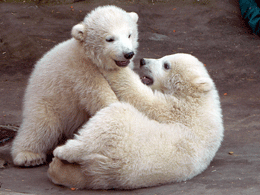
These polar bear cubs might become members of an endangered species soon. (Photo: Vera Le Bail)
GELLERMAN: It’s Living on Earth. I’m Bruce Gellerman. The Bush administration is in legal hot water over what to do with an animal that likes its water very cold: the polar bear. A federal judge has ordered the administration to decide, once and for all, if polar bears need protection under the Endangered Species Act. The judge’s ruling comes in response to a lawsuit filed by a number of environmental groups, including the Center for Biological Diversity, where Bill Snape is the senior counsel.
SNAPE: Well the good news is they must make a decision now by May 15th. The bad news potentially is that the administration could still create legal loopholes, they could still deny protection to the polar bear. So we’ll wait and see what the actual substance of their decision is on May 15th.
GELLERMAN: So the feds can decide that the bears don’t belong on the list.
SNAPE: They very well could decide that. I think perhaps a more likely scenario is that they will write the final rule in such a manner that oil and gas activities in polar bear habitat can still go forward despite the listing of the bear. The Endangered Species Act is an incredibly flexible law – not many people realize that – and there are some wise and not so friendly people to the bear at the Interior Department who I think are looking at ways to get around the law.
GELLERMAN: So what legal precedent, if any, does this set?
SNAPE: Well I think it’s very significant that if the polar bear were to be listed, and I think eventually it will be listed, it will be the first major species to be listed as a result of global warming impacts. It is not a huge deal in the respect that listings under the Endangered Species Act in general should follow a very logical, rational scientific process. It’s the Bush administration that has convoluted that process as it relates to the polar bear, because global warming doesn’t comport with their notion of truth.
GELLERMAN: There was a Canadian science advisory group that recently said the bear doesn’t need to be listed as endangered.
SNAPE: Well, under the Canadian law, there are actually different gradations of legal protection. That Canadian panel did say that it was worthy of some protection. But remember, that Canadian panel is allowed to take politics into account. The U.S. Endangered Species Act listing process, which is what we’re talking about here, is a science-only determination. It’s clear that politics, and oil and gas politics particularly, are against polar bear protection, but when you look at it from a sheer biological point of view, there are still thousands of bears left, but they are declining precipitously and their Arctic ice habitat is melting before our very eyes.
GELLERMAN: So is this about the bears, or is this about prohibiting, you know, invasion of their habitat by oil drilling companies?

(Photo: Vera Le Bail)
GELLERMAN: Is there any oil exploration going on right now, or proposed in the areas where polar bears populate?
SNAPE: Absolutely. In the Chukchi sea, an area about 30 million acres is now under lease for oil and gas activities by the very Department of Interior that is denying protection for this bear. So there is a lot at stake right now, not only with regard to the polar bear’s actual habitat, but with regard to the very type of oil and gas activities that are exacerbating global warming.
GELLERMAN: What happens May 15th if the Department of Interior does nothing?
SNAPE: They’ll be dragged into the court again. They could be found in contempt of court. And the good news here is that finally a federal judge is onto their shenanigans, and I think the administration will be hard pressed at this point to ignore what this judge has said.
GELLERMAN: Well, Bill Snape, thank you very much – really appreciate it.
SNAPE: Thank you.
GELLERMAN: Bill Snape is senior counsel for the Center for Biological Diversity in Washington D.C.
Related links:
- U.S. Fish and Wildlife Service Endangered Species Program
- Center for Biological Diversity
[MUSIC: Material “Ruins (Submation Dub)” from Hallucination Engine (Axiom Records – 1994)]
Sealing the Sarcaphagus

The aftermath of the 1986 nuclear disaster.
GELLERMAN: Now an update to a story I first reported in 1996, on the tenth anniversary of Chernobyl, a place synonymous with nuclear disaster.
[MAN SPEAKING RUSSIAN; SOUND OF ENGINE RUNNING]
GELLERMAN: On April 26,1986, Chernobyl reactor number four at the Soviet atomic power plant in Ukraine erupted into a nuclear volcano, spewing radiation around the world.
[FOOTSTEPS, SPRINGS CREAKING]
GELLERMAN: We’re standing at ground zero. Today what remains of the melted number four reactor is entombed in a massive 24-story sarcophagus. But even 300,000 tons of steel and concrete can’t contain the intense radiation within.
[MAN SPEAKING RUSSIAN]
TRANSLATION VOICEOVER: Four point five millirems per hour.
GELLERMAN: Today, almost exactly 22 years after the world’s worst nuclear accident, the Chernobyl power plant, with its hastily constructed sarcophagus entombing the doomed reactor, is still one of the most radioactive places on the planet.
Now finally, after years of delays, there are plans – and one and a half billion dollars – to deal with the contaminated site. Half a billion will go to a French construction company to build an enormous confinement shelter, says Ken Brockman, Senior Safety Consultant with the World Nuclear Association.
BROCKMAN: You need to realize it’s very massive. We’re talking something here that will totally cover the entire building that was there: three to four football fields long, two football fields wide and a football field high. Picture one of the large domes that people play tennis under; that’s sort of the shape.
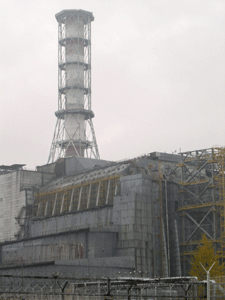
The 'sarcophagus,' the temporary shell that was placed over the structure to contain radiation, is now becoming unstable. (Photo: David Thair)
BROCKMAN: There will be a point in time with that structure you will say, we need to do something additional to it. I’m very confident that the technology of the future will have some capabilities to be able to supplement this or even replace it in a way that we can’t even fathom today. But, if you don’t even accept that, you could take the technology of today. You could build a little bit bigger arch, one that’ll handle two Statues of Liberty, and put that right over the top of it.
GELLERMAN: You know, in Russian they called it a motroshka doll – that’s the nesting dolls, see one goes in on top of the other.
BROCKMAN: I never thought of it in that way, but you know the matroshka would certainly be a philosophy that could be used, and it’s probably a very good one because if you’ve ever seen these nested doll sets, each one is perfectly maintained inside the other.
GELLERMAN: It’s estimated 95 percent of the nuclear fuel – 200 tons of radioactive material – still remains buried within the sarcophagus. Some of the radioactive elements have a half-life of several thousand years. It took 800,000 Soviet soldiers and workers to construct what was supposed to be a temporary tomb.
Jim Riccio, nuclear policy analyst for Greenpeace, agrees that a new shelter to prevent another disaster is critical, but says we have yet to learn the real lesson of Chernobyl.

The aftermath of the 1986 nuclear disaster.
GELLERMAN: Once, 120 thousand people lived within 30 kilometers – about 20 miles – from the Chernobyl power plant. They were evacuated after the disaster and have been prohibited from moving back. Ever since, it’s been a landscape of ghosts – abandoned schools and homes, a huge rusting Ferris wheel. And Philip Metcalf, from the Division of Radiation Transport and Waste Safety at the International Atomic Energy Agency says, it’s likely to remain that way for many, many years.
METCALF: Within, you know, probably five to ten kilometers – that’s an area that’s probably going to have to be sort of sanitized for the next two or three hundred years.
GELLERMAN: Plans haven’t been finalized yet, but Metcalf says the remains of the doomed reactor will most likely be buried in the area around Chernobyl.
METCALF: The idea will be to dismantle the existing structure, the so-called sarcophagus, dismantle that, remove it, and then remove the radioactive residues from the damaged reactor core. So probably within the next sort of fifty years, that work will take place, and hopefully fifty, sixty years hence, there will be nothing left and the actual – the new construction can then be dismantled.
GELLERMAN: Construction of the Chernobyl New Safe Confinement Structure is scheduled to begin late this fall.
Related links:
- International Atomic Energy Agency
- Green Peace
[MUSIC: Peter Calandra “What Now ?” from Jellysmoke Soundtrack (Moviescore Media – 2008)]
Re-education at Camp Chaparral
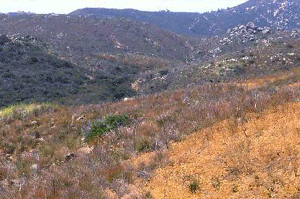
Chaparral being type-converted to weedy, non-native grassland in San Diego County. (Photo: Richard W. Halsey)
GELLERMAN: The first wildfires of the season have already broken out in California, turning about 250 acres of National Forest there to a crisp. But it wasn’t giant redwoods or sequoias that went up in smoke – it was a family of shrubs known as chaparral.
Chaparral covers most of Southern California’s four national forests, and scientists say in some areas it’s in peril. Living on Earth's Ingrid Lobet visited the San Bernardino National Forest and has our story.
[FOOTSTEPS COME TO A STOP]
BORCHERT: What we're looking at are California sagebrush, and it creates this really quite pretty blueish-gray cast over the landscape.
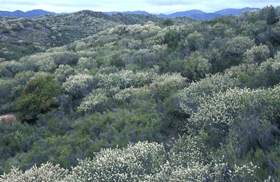
Ceanothus chaparral in the Trabuco Ranger District of the Cleveland National (Chaparral) Forest. (Photo: Richard W. Halsey)
BORCHERT: I want you to smell that. So that’s Artemisia, and so that’s the aromatic oils…
LOBET: The intoxicating scent of crushed California Sagebrush, or Artemisia, fills the air. But this little gray blue sagebrush stands apart now in a sea of bright green grasses.
[SOUND OF WET PLANT]
LOBET: These grasses arc across the face of the mountain and look fat and happy. Hugh Safford is lead ecologist for the Forest Service in California. He and Borchert survey the grass-covered mountainside.
SAFFORD: I mean, basically every species that we can touch right here is from somewhere in Central Asia or North Africa or Southern Europe.
Yeah, essentially what you’ve done is you’ve converted what was a shrub-dominated system to a grass-dominated system. I mean it's really that simple.
LOBET: So somebody might look at this hillside and they might say, 'the hills look so beautiful; look at that bright green color!' But you see something different.
SAFFORD: Yeah, oh, it's beautiful. It’s green and there are – there’re a lot of flowers, and I'm not gonna to tell people it's not beautiful.
BORCHERT: Maybe ecologically it's – right (chuckles) – not beautiful.
SAFFORD: No, it's a disaster ecologically. I mean it's basically just a hillside of weeds. That's really what it is.
LOBET: Foothills covered in weeds, in what Americans have set aside to protect as forest. What used to be here is called coastal sage scrub. It only exists along the West Coast and gets a little moisture from the Pacific Ocean, 60 miles away. Nine tenths of what once existed is gone now, even here where it's been protected. What brought this ecological swap from sage to grasses, the ecologists say, is people – setting fires. But don't we hear these plants are ‘fire-adapted’? Aren't they supposed to burn?
SAFFORD: Yeah you hear this all the time: ‘they’re fire-adapted’! You read in the newspaper, people talk about 'oh that stuff burns every ten years!' you know, that’s what it’s, you know – no, no, that's not at all what it’s meant to do and when burns that often, it starts looking like this.
LOBET: Truth is, Safford says, these foothills are probably only supposed to burn every 50 to 100 years. Before 13 million people settled in the Los Angeles Basin, he says, there were few fires; lightning rarely struck in the foothills. Now the frequency of fire has completely changed.
SAFFORD: There are a whole lot of places across the front of the San Bernardino Mountains in which there have been ten, eleven, twelve, thirteen fires over the last 100 years. You can't support woody plants under that kind of fire regime. You can't do it. It's impossible. And those kind of systems degrade into what we are looking at right here, which is essentially a lot of bare ground, and a lot of annual species.
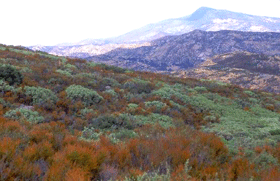
Fall in the chaparral occurs during the first few weeks of "summer." The reddish-brown hues are from the fading flower clusters on the top of the shrubs. (Photo: Richard W. Halsey)
BORCHERT: They re-sprout after a fire, but if you burn ’em again too quickly, over time they just lose the vitality, the ability to re-sprout, and then they go away. In general this would have been a much more bio-diverse plant community than the one that’s replaced it.
[FOOTSTEPS ON GRAVEL]
LOBET: Uphill in the San Bernardino National Forest is even drier chaparral.
BORCHERT: We would call it knob cone pine chaparral.
LOBET: In general, Mark Borchert says, there’s much more of this landscape left in California.
LOBET: So our kids, our grandkids, if they want to go hiking in a forest that's a chaparral forest, chances are they’re going to be able to?
BORCHERT: I think that's correct.
LOBET: But his colleague Hugh Safford is less sanguine.
SAFFORD: Let's be honest. The number of ignitions that the fire agencies put out every year is just mind-boggling. It really is.
LOBET: Both cite climate models that pretty much agree California is in for hotter, drier summers, which means more fires, or ignitions. Some officials even say fire season is now year round.
SAFFORD: The situation is this: as more and more people move into the system, it simply means more and more ignitions, and as we have, you know, drought years like we had in 2002 was a bad one. Last year was the worst one in recorded history and that kind of thing… Chaparral’s already flammable, but it's gonna set it up to be even more flammable. And add a Santa Ana wind in October and you're sort of stacking the deck now, you know, more people, more ignitions, drier summers.
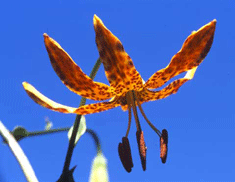
The chaparral is home to colorful wildflowers like this Humboldt’s Lily at the base of Viejas Mountain in San Diego County. (Photo: Richard W. Halsey)
SAFFORD: In the last four years, they’ve probably burned up two to three million acres of chaparral and nearly a hundred thousand acres of that were re-burned in '07 that had already burned in '03. I mean, you're talking about a hundred thousand acres of probable loss of chaparral.
[CHILDREN PLAYING; TWO SHORT BLOWS ON WHISTLE]
TEACHER: Room 17, come forward.
[BIRD SONG]
HALSEY: Hello, little friends. My name’s Mr. Halsey. You can call me Rick, otherwise known as the Voice of the Chaparral.
LOBET: One man who watched those 100,000 acres in San Diego burn twice in five years has now made chaparral his life's work. Today Rick Halsey is out in the sweet smelling hills with a class of fourth graders.
HALSEY: First of all I have to say something, I have to say something. I have been with adults for like two weeks. Ewwugh – so glad I’m with kids today.
LOBET: Halsey is a former biology teacher. He warms the kids up teaching them the birdcall for the wrentit. They're so engaged they hardly laugh at the name.
[HALSEY WHISTLES BIRD CALL; KIDS IMITATE HIM]
HALSEY: Oh, you could get a boyfriend or girlfriend any day!
[KIDS LAUGH; SAY EWW]
Halsey: That’s how they do it, you know. When birds sing, they're usually looking for a boy or girlfriend, or they're telling the guy next door: "Get out of my territory!" That’s what they’re saying usually.
LOBET: Then comes the name for the hillside plants these San Diego County kids have seen their whole lives.
HALSEY: Chaparral!
HALSEY AND KIDS: C-H-A-P-A-R-R-A-L.
HALSEY: Did you know there is more chaparral in California than any other plant community?
LOBET: Halsey says when people head into the national forests, they're looking for pine trees and have a sort of 'are we there yet?' attitude toward the plants that make up the majority of their native ecosystem. Or worse, see them as a weedy fire hazard that has to be cleared.
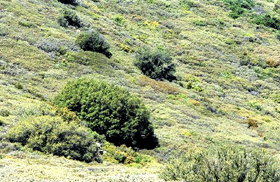
A dense carpet of 8-foot-tall old growth manzanita and scrub oak chaparral in Guatay Mountain, San Diego County. (Photo: Richard W. Halsey)
LOBET: Halsey would like the four national forests of southern California to be renamed National Chaparral Recreation Areas, because he says people just can't appreciate chaparral when they're looking for trees.
HALSEY: And when you don't know something exists ’cause it doesn't have a name, it has a tendency to be exploited, and it can disappear without anybody knowing it ever was there.
LOBET: When talk turns to the San Bernardino National Forest, even Halsey sounds like hope is scarce.
HALSEY: Well, the San Bernardino Forest – the front country it’s called – it's pretty devastated. And I don't see much that can be done to change that, because the fire frequency is so high. Some of those areas burn every year.
LOBET: On the other hand, he says, devastated lands can be turned around when communities adopt them, yanking out grasses and replanting. Also, as new homes crowd their way up the skirts of the mountains, developers could build in blue green spaces, where new residents could walk among native plants, instead of palm trees.
HALSEY: And then all of a sudden, they start smelling the sage and the sumac. And they get connected with it. And they get this feeling when they walk out in the morning with their coffee, and they can smell the air with these fragrances that have been here for millions of years.
[KIDS TALKING; HALSEY: SMELL, SMELL, SMELL, SMELL, SMELL, SMELL, SMELL!]
LOBET: Halsey waves a sprig of white sage by the fourth graders in hopes of making some primal connection.
[HALSEY: SMELL, SMELL, SMELL, SMELL, SMELL, SMELL, SMELL, SMELL! KIDS: OOH AND AHH, SAY ‘YUMMY!’ ‘CANDY!’; HALSEY SAYS, ‘DID YOU SMELL IT?’ KIDS SAY ‘YEAH’]
LOBET: Perhaps the cure for a devastated landscape germinated here today. For Living on Earth, I'm Ingrid Lobet.
HALSEY: Oh it’s a phainopepla! You see that bird up in that tree? He had these little white wing bars on there? He was catching a little moth. Okay, anyway, I’m getting distracted.
Related link:
The California Chaparral Institute
[MUSIC: Alex Houghton “The Bear”]
GELLERMAN: Coming up – Doctor Doolittle isn’t the only one who does it: talking dolphin and signing with great apes, just ahead on Living on Earth.
Beautiful Minds
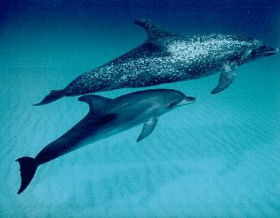
Dolphins might not look like apes, but their brains work similarly. (Photo: South Florida Water Management District)
GELLERMAN: It’s Living on Earth, I’m Bruce Gellerman. A bottle-nosed dolphin is about as closely related to a gorilla as a mouse is to an elephant. But according to the authors of the new book “Beautiful Minds: the Parallel Lives of Great Apes and Dolphins,” those animals – and we humans – have a lot in common. We’re mammals, we have big brains, complex social lives, communicate, and can use tools. Maddalena Bearzi, a dolphin biologist, is co-author of the book.
BEARZI: These dolphins basically use a sponge, and they put it on the top of their beak to protect themselves from abrasive sand and toxic animals they can find on the bottom when they look for food.
GELLERMAN: I recently spoke with Maddalena Bearzi, and her co-author, primatologist Craig Stanford, about dolphins and apes.
STANFORD: Here you have these two animals that we’re all familiar with, and we think of them as being just utterly different. What could be more different than an animal that lives in the ocean, is shaped like a cruise missile, doesn’t have any arms or legs in a real sense, and then you have another animal that it lives in the forests of Africa and Asia, and kind of looks like us, but with lots of body hair. And in fact, there are striking parallels. And so we wrote the book because there’s an emerging awareness in the scientific community, and maybe not yet in the public, of just how interestingly similar and parallel these two very different mammals are. And of course, what they tell us about the origins and the nature of human intelligence, and of human nature.
BEARZI: Dolphins and whales, cetaceans in general are very smart. They have a lot in common with us. They can form alliances, how we do, they have extremely complex society. How we describe in the book, they can be clever politicians.
STANFORD: I guess the key question is how do we define intelligence? I mean, intelligence is probably best defined in evolutionary terms as being a survival skill. And so you have a lot of animals out there in the world that of course lower animals don’t need intelligence to cope with their day-to-day struggles, and they have done very well, some of them, for hundreds of millions of years with tiny, tiny brains. For humans, and our closest relatives, and also for this other group of animals, the dolphins, big brains are highly adaptive. They’re highly useful and important in increasing their reproductive success and increasing their survival success.
GELLERMAN: Maddalena Bearzi, you write that dolphins not only have language, but that there was a neurophysiologist, John Lilly, who said he could speak dolphinese?
BEARZI: (chuckles) Yes, exactly. John Lilly in the sixties thought that he could talk to dolphins, so spent a lot of time with these animals in captivity trying to break this language barrier between human and dolphins. Things didn’t go too well, unfortunately, but dolphins have some type of language that is not exactly like ours – when you do research, you can put a hydrophone in the water and listen to the whistle of these dolphins. We discover a few years ago that these animals can even have a signature whistle, and basically signature whistle are sounds that they make to recognize each other.
GELLERMAN: What about the great apes? Do they have languages?
STANFORD: Well in their natural environment, you know, in an African forest, let’s say, then they have a very complicated communication system. They – chimpanzees - use long calls, long-distance calls to stay in touch with each other, they have short contact calls that indicate everything from submission to anger and so forth. They don’t have what we would call language in human terms in artificial settings, where you’ve had baby chimps, and other great apes, reared in human homes as though they were human children. And in those cases, many famous studies have been done showing that they do develop, you know, rudimentary language capabilities using sign language, or using some other means of communication, because they just don’t have the mechanical means in the tongue and the palate and so forth to actually speak. But they develop language to the level of, let’s say, a human toddler, which is, which is quite a profound thing.

(Courtesy of South Florida Water Management District)
STANFORD: (chuckles) How is my great ape sign language? Not nearly good enough. And I’ve actually – I’ve had very, very, you know, trivial little conversations in sign language with some of the famous sign language-using chimps, like Washoe, but using a translator, because I don’t speak sign language.
GELLERMAN: And Dr. Bearzi, can you whistle like a dolphin?
BEARZI: I try sometimes, but it doesn’t seem to work very well.
GELLERMAN: Give me an example.
[LAUGHTER; BEARZI IMITATES A DOLPHIN WHISTLE]
STANFORD: That was great! Oh, excellent, I’ve never heard that before.
GELLERMAN: Maddalena Bearzi, what do you think of these places where you can swim with the dolphins?
BEARZI: I’m actually, and probably the public won’t like my answer, but I’m actually very contrary [to] swimming with the dolphins. If you look at dolphins in the wild, these animals live in an open environment. They have this extremely complex society. If you put these animal in a tank to allow people to swim with the dolphins, you really take away a lot of their life. Sometimes these animals come close to us because they’re curious, even when we do research, but we need to respect their environment; we need to respect their habitat.
GELLERMAN: You write in the book that the dolphins at one point formed a ring around a girl who was trying to commit suicide by drowning herself in the ocean – you say they protected her. And I’m wondering, did they know what they were doing? Or is it us interpreting what they were doing?
BEARZI: Yeah, it’s very difficult to say. The dolphins formed – it’s true, form a ring around this girl, and then they left after we took the girl that was actually committing suicide in our boat to save her. It could be just our interpretation – it’s, there are many cases in the past where dolphins are thought to save humans, but we don’t really have a scientific proof for that.
GELLERMAN: There are four species of great apes, right?
STANFORD: Yes. There are gorillas, orangutans, bonobos, and chimpanzees.
GELLERMAN: And you write, what, there’s just about a quarter of a million left on the planet.
STANFORD: Yeah, I mean there are seven billion people today, and chimpanzees are the most numerous of the great apes in the wild, and they number probably fewer than 200,000 in the wild, and all of the other three great apes have been reduced to only in the – a few thousand, or tens of thousands per species.
BEARZI: Same things is happening for dolphins. Most of the species are threatened or endangered species. For the first time, we’re seeing species of dolphins getting extinct under our own eyes – it’s a river dolphin in the Yangtze River in China.
STANFORD: The problems facing the great apes today mostly revolve around habitat loss, you know forest being cut down, and then also direct human problems like hunting. Because bush meat, which is a term Americans tend not to know, is a profound problem for the great apes. Chimps and gorillas, and bonobos, are eaten, and their meat is sold at very high prices in African markets.
BEARZI: One of the main reason, I think, why Craig and I wrote this book is not only to talk about all the parallel of these amazing animals that are so close to us, but also to bring attention to the public the status in which these animal found themselves today.
GELLERMAN: Well I want to thank you both very much.
STANFORD: Thanks a lot.
BEARZI: Thank you. You’re welcome.
GELLERMAN: Maddalena Bearzi is co-founder and president of the Ocean Conservation Society. Craig Stanford is co-director of the Jane Goodall Research Center at USC. Their new book is called “Beautiful Minds: The Parallel Lives of Great Apes and Dolphins.”
Related link:
To learn more about the book “Beautiful Minds,” click here.
A Rolling Stone Gathers Trees
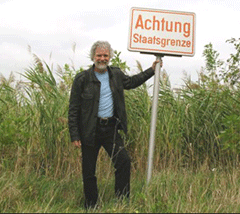
While on tour in Germany, Chuck Leavell campaigned for sustainable forestry. (Courtesy of Chuck Leavell)
GELLERMAN: They’re known as the greatest rock ‘n roll band in the world.
[MUSIC: Rolling Stones “(I Can’t Get No) Satisfaction” from ‘Hot Rocks 1964-1971’ (Abkco Records – 2002)]
GELLERMAN: No moss grows on these Rolling Stones – their recent tour lasted two years. When the Rolling Stones ended their tour in 2007, their keyboardist, Chuck Leavell, known as the fifth stone, kept going, rolling and recording around Europe. And now, his latest double CD set has just been released. It’s called ‘Live in Germany: the Green Leaves and Blue Notes Tour 2007.’
[“Route 66” from ‘Live In Germany – Green Leaves And Blue Notes Tour 2007’ (Evergreen Arts – 2008)]
GELLERMAN: Chuck Leavell is not just a musician. He’s also an award-winning advocate for sustainable forests, and the author of three books about trees, including his latest for children: “The Tree Farmer.” Chuck Leavell, joins me from a studio in Southern California. Chuck, it’s good to talk to you.
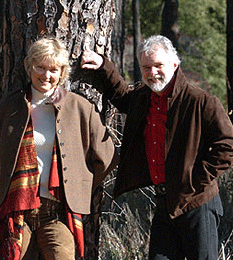
Chuck Leavell with his wife Rose Lane in their tree farm in Georgia. (Courtesy of Chuck Leavell)
GELLERMAN: You know, I was listening to your new album and noticed in the liner notes that you say you’ve got three passions: your family, your trees, and your music. How come you put your music after trees?
LEAVELL: Well, I’m not sure that’s in any particular order. Family first – I just feel like I’m the luckiest guy in the world, man, I have a wonderful family: two beautiful daughters; Roseline, my wife, and I have been together over 35 years now. And of course to be able to play music with all the different artists that I’ve been fortunate to work with is a joy, and then, somewhere along the way I got interested in trees and forests and that has become equally a big, big passion for me.
GELLERMAN: You’ve got a 2,200 acre farm – a Charlene Plantation, I think you call it.
LEAVELL: That’s right. Some of this land, Bruce, goes back to my wife’s heritage. The particular property that we live on and that she inherited from her grandparents was something that they bought back in the 1930’s.
GELLERMAN: So it’s a tree farm in Twiggs County (laughs).
LEAVELL: (laughs) That’s right. That is absolutely right. Twiggs County, if you put your finger on the map right in the center of Georgia, you’ll be pressin’ on top of my head.
[MUSIC: “Georgia On My Mind” from Live In Germany – Green Leaves And Blue Notes Tour 2007 (Evergreen Arts 2008)]
GELLERMAN: So is Georgia on your mind always?
LEAVELL: (laughs) Of course, of course. I love my home, man, living where I live and being involved in forestry provides an incredible balance for me. You know, when you’re out touring with Rolling Stones or some of the other artists I’ve been fortunate to work with, it’s a very electric atmosphere. There’s a big buzz going on all the time, people around you, big crowds, lots of excitement. After a while, all of that tension, all of that feeling, all those vibrations begin to take a little bit of a toll. Even when I’m on the road, if I can find a green space, a park, a forest to visit, and certainly, when I do get home and walk amongst the trees and hear the sound of the wind through the pines, or the sound of the crunch of leaves under your feet, it provides a certain balance that for me is essential.

Chuck Leavell playing with the Rolling Stones. (Courtesy of Chuck Leavell)
LEAVELL: Well that’s right. This resource of wood is probably our most precious resource that we have in this country. It’s organic, it’s natural, and it’s renewable. The number of things that come from the forest that we use, whether it be fine furniture, whether it be building materials for our homes and schools and churches, or whether it be paper products that we use, books, magazines, newspapers, whether it be musical instruments – just about every musical instrument has an element of wood in it, and even – let’s take a saxophone – even that won’t work unless you have that wooden reed. So when you put your mind to it and you begin to realize the gifts of the forest, you begin to realize how important this resource is to America and to the world.
And now, what’s interesting, is that we’re talking about other gifts that the forests give us, like the ability to combat climate change. We all know that trees sequester carbon. Also, biofuels – there’s been a lot of discussion lately about the effects of corn to make ethanol, and what that’s done to the price of corn, and how that has had an ill effect. But ethanol can be made from wood chips. So, these are exciting things, and it’s just something everyone needs to realize – all the wonderful things that the forest gives us.
GELLERMAN: But growing trees, getting wood, requires patience, and I can’t imagine your touring with the Rolling Stones involved much patience – I mean, they went worldwide. Your role with the Rolling Stones, as I understand it, on this tour was, in part, not just play with them but to be the program manager – decide what the playlist was.
LEAVELL: You know, I’ve been with the band now for 25 years, and the role has evolved. Mick and I began to work together on the set list even before the band would go on tour, when we were in the rehearsal stage. And because every tour you wanna try to do a little something different – certainly there’s the iconic songs, “Brown Sugar,” “Satisfaction,” “Jumping Jack Flash,” that you’re more or less obligated to play every show – but then there’s a lot of space for change. And we would get together on interesting ideas and songs that were a little more obscure.
GELLERMAN: I have a clip of you and Mick Jagger – I want you to listen to it. It’s pretty funny.

While on tour in Germany, Chuck Leavell campaigned for sustainable forestry.
(Courtesy of Chuck Leavell)
JAGGER: Yeah, sure, sure, no, I’m getting it – I’m down to that –
LEAVELL: But I’m not doing it that much, because I don’t want it to be too pretty, you know –
JAGGER: No, don’t want it to be too pretty –
LEAVELL: No –
JAGGAR: – and no country
LEAVELL: No, no, no, no it ain’t going to be country. Just cause I’m from Georgia, you know?
JAGGER: (laughing)
JAGGER: Don’t get defensive!
[Leavell laughs.]
GELLERMAN: (laughs) He didn’t want it too country.
LEAVELL: (laughs) No, not too country. Although it’s funny, because the Stones as a whole loved country music. When you think of songs like “Faraway Eyes” or “Dead Flowers,” you know I mean, that’s straight country, man.
GELLERMAN: Well, I’m thinking of “Honky Tonk Woman,” which you have on your latest CD.
LEAVELL: Ah, yes. Love that cowbell.
[COWBELL; APPLAUSE; MUSIC STARTS]
LEAVELL: Well, you know, “Honky Tonk Women” is a special song for me. I can remember where I was when I first heard that song very well. I was in one of my first bands. We were living in Nashville, Tennessee. The guitar player came running in the door with a 45 and said, ‘I’ve got it! I’ve got it!’ And I said, ‘you got what, man?’ He said, ‘I was listening to the radio, I heard this new Stones song, it drove me crazy, I pulled over on the side of the road to listen to it, I went straight to the record store, I bought it, and here it is!’ And it was Honky Tonk Women, and we listened to that record all day long. We dissected it upside-down and backwards and I’ve just always loved that tune.
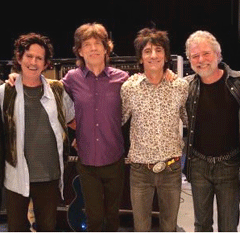
From left to right; Keith Richards, Mick Jagger, Ronnie Wood, and Chuck Leavell. (Courtesy of Chuck Leavell)
[MUSIC: “Honky Tonk Women” from Live In Germany-Green Leaves And Blue Notes Tour 2007 (Evergreen Arts 2008)]
GELLERMAN: Back in 2003, you played the national anthem for President George Bush. He referred to you as a tree raiser (laughs).
LEAVELL: (laughs) Well, I think anybody that’s followed President Bush is familiar with ‘Bushisms,’ and I think he was at a loss of words as to what to call me. ‘He’s a tree-raiser, or a tree-grower, or whatever you call them!’ That’s what he said (laughs). But the event was actually the signing of the Healthy Forest Restoration Act. And I was very, very pleased that it was passed, because I did maybe have some small role in helping that along. I went to Washington D.C., and I do sometimes go up there and discuss forest policy with the leaders in Congress, and sometimes with the, even the White House, and I was invited to come up there and do the national anthem (laughing).
GELLERMAN: Well, it’s been a real pleasure there, Chuck. What song should we go out on?
LEAVELL: I wrote a song called “Savannah” on my next-to-last CD. It’s called Southscape. If people, anybody out there, have been to the city of Savannah, the picture I was trying to paint was of the huge, beautiful live oak trees that are there with the Spanish moss hanging down from them. It has a beautiful, sweet feeling to it.
GELLERMAN: Well, Chuck, thank you very much. It’s been a real pleasure.
LEAVELL: Great. Thanks, Bruce.
GELLERMAN: Chuck Leavell, the fifth or sixth Rolling Stone depending on how you count them, is a tree farmer, author, and keyboardist. His new double CD is called ‘Live in Germany: Green Leaves and Blue Notes Tour 2007.’
Related links:
- To learn more about Chuck's tree farm, click here
- Chuck Leavell’s website
[MUSIC: “Savannah” from Southscape (Evergreen Arts – 2005)]
GELLERMAN: On the next Living on Earth – A rose by another other name might smell as sweet.
MAN: You can be delicate and call it waste, but it’s garbage. Garbage is our bread and butter, and we’d like to make a little less of it and be able to turn a little bit more of it into things that people can use every day.
GELLERMAN: We celebrate Trashosaurus’s birthday at the Children’s Garbage Museum – next time on Living on Earth
GELLERMAN: Living on Earth is produced by the World Media Foundation. Our crew includes Ashley Ahearn, Bobby Bascomb, Eileen Bolinsky, Ingrid Lobet, Helen Palmer, Mitra Taj and Jeff Young, with help from Jennifer Baessler, and Sarah Calkins.
Our interns are Annie Jia and Margaret Rossano. Jeff Turton is our technical director. Alison Lirish Dean composed our themes. You can find us at LOE dot org. Steve Curwood is our executive producer. I'm Bruce Gellerman. Thanks for listening.
ANNOUNCER: Funding for Living on Earth comes from the National Science Foundation, supporting coverage of emerging science, and Stonyfield Farm: organic yogurt and smoothies. Stonyfield pays its farmers not to use artificial growth hormones on their cows. Details at stonyfield.com. Support also comes from you our listeners, the Ford Foundation, the Town Creek Foundation, the Oak Foundation supporting coverage of climate change and marine issues and Pax World Mutual Funds: socially and environmentally responsible investing. Pax World: for tomorrow. On the web at paxworld.com.
ANNOUNCER 2: PRI: Public Radio International.
Living on Earth wants to hear from you!
Living on Earth
62 Calef Highway, Suite 212
Lee, NH 03861
Telephone: 617-287-4121
E-mail: comments@loe.org
Newsletter [Click here]
Donate to Living on Earth!
Living on Earth is an independent media program and relies entirely on contributions from listeners and institutions supporting public service. Please donate now to preserve an independent environmental voice.
NewsletterLiving on Earth offers a weekly delivery of the show's rundown to your mailbox. Sign up for our newsletter today!
 Sailors For The Sea: Be the change you want to sea.
Sailors For The Sea: Be the change you want to sea.
 The Grantham Foundation for the Protection of the Environment: Committed to protecting and improving the health of the global environment.
The Grantham Foundation for the Protection of the Environment: Committed to protecting and improving the health of the global environment.
 Contribute to Living on Earth and receive, as our gift to you, an archival print of one of Mark Seth Lender's extraordinary wildlife photographs. Follow the link to see Mark's current collection of photographs.
Contribute to Living on Earth and receive, as our gift to you, an archival print of one of Mark Seth Lender's extraordinary wildlife photographs. Follow the link to see Mark's current collection of photographs.
 Buy a signed copy of Mark Seth Lender's book Smeagull the Seagull & support Living on Earth
Buy a signed copy of Mark Seth Lender's book Smeagull the Seagull & support Living on Earth

